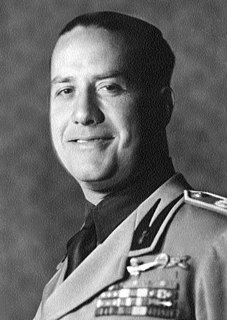Related Research Articles

Gian Galeazzo Ciano, 2nd Count of Cortellazzo and Buccari was an Italian diplomat and politician who served as Foreign Minister in the government of his father-in-law, Benito Mussolini, from 1936 until 1943. During this period, he was widely seen as Mussolini's most probable successor as head of government.
Franco Mimmi is an Italian journalist and novelist.

Curzio Malaparte, born Kurt Erich Suckert, was an Italian writer, filmmaker, war correspondent and diplomat. Malaparte is best known outside Italy due to his works Kaputt (1944) and La pelle (1949). The former is a semi-fictionalised account of the Eastern Front during the Second World War and the latter is an account focusing on morality in the immediate post-war period of Naples.

Don Emilio Pucci, Marchese di Barsento was an Italian fashion designer and politician. He and his eponymous company are synonymous with geometric prints in a kaleidoscope of colors.

Luigi Barzini Jr. was an Italian journalist, writer and politician most famous for his 1964 book The Italians, delving deeply into the Italian national character and introducing many Anglo-Saxon readers to Italian life and culture.

Edda Ciano née Mussolini was the daughter of Benito Mussolini, Italy's fascist dictator from 1922 to 1943. Upon her marriage to the fascist propagandist and Foreign Minister Galeazzo Ciano, she became Edda Ciano, Countess of Cortellazzo and Buccari. Her husband was executed in January 1944 for his role in Mussolini's ouster. She strongly denied her involvement in the National Fascist Party regime and had an affair with Chinese warlord and political figure Chang Hsüeh-liang after her father's execution by the Italian partisans in April 1945.

Augusto Genina was an Italian film pioneer. He was a movie producer and director.

Mussolini and I is a 1985 made-for-television docudrama film directed by Alberto Negrin. It chronicles the strained relationship between Italy's fascist dictator Benito Mussolini and his son-in-law and foreign minister, Count Galeazzo Ciano, based on Ciano's diaries. Made in English as an Italian-French-German-Swiss-Spanish-US co-production, with Bob Hoskins, Anthony Hopkins and Susan Sarandon in the leading roles, it first aired on Rai Uno on 15 April 1985 in a 130-minute version. On 8 September 1985, it premiered in the USA on HBO in an extended four-hour version.

Giovacchino Forzano was an Italian playwright, librettist, stage and film director. A resourceful writer, he authored numerous popular plays and produced opera librettos for most of the major Italian composers of the early twentieth century, including the librettos for Giacomo Puccini's Suor Angelica and Gianni Schicchi.

Arrigo Petacco was an Italian writer, historian and journalist.

Antonio Pennacchi was an Italian writer, winner of the Strega Prize in 2010 for his novel, Canale Mussolini.

Il processo di Verona is a 1963 Italian historical drama film directed by Carlo Lizzani. The film tells of the final phases of the Italian fascist regime, in particular the affair of the 1944 Verona trial, in which Galeazzo Ciano, Emilio De Bono, Giovanni Marinelli and other eminent Fascist officials were sentenced to death and almost immediately executed by a shooting detachment, while Tullio Cianetti was sentenced to 30 years imprisonment.

Giordano Bruno Guerri is an Italian writer, journalist, and historian. He is an important scholar of twentieth-century Italy, in particular of the Fascist period and the relationship between Italians and the Catholic Church.

Leopoldo Longanesi was an Italian journalist, publicist, screenplayer, playwright, writer, and publisher. Longanesi is mostly known in his country for his satirical works on Italian society and people. He also founded the eponymous publishing house in Milan in 1946 and was a mentor-like figure for Indro Montanelli: journalist, historian, and founder of Il Giornale, one of Italy's biggest newspapers.
Domenico Bartoli was an Italian journalist and essayist. In 1960 he became the director of the Il Resto del Carlino, a Bologna-based mass-circulation daily newspaper, remaining in the position for ten years.
Vittorio Gorresio was an Italian Journalist-commentator and essayist.

Marcello Cesare Augusto Petacci was an Italian surgeon and businessman, the brother of actress Maria Petacci and of dictator Benito Mussolini's lover Clara Petacci.

Giampaolo Pansa was an Italian journalist-commentator and, especially during his later years, a prolific author of books and essays. Much of his writing was rooted in recent or contemporary history, notably with regard to the antifascist resistance of the Mussolini years.

Giorgio Forattini is an Italian drawer, cartoonist and journalist. Since 1973 his cartoons have been published on the chief Italian newspapers. Forattini comments "with a corrosive and irreverent humor, the events of Italian and international political life." His cartoons have been published in many collections, including Referendum reverendum (1974), Quattro anni di storia italiana (1977), Nudi alla meta (1985), Insciaquà (1990), Bossic Instinct (1993), Il libro a colori del post-comunismo (1998), Foratt pride (2000), Oltre la Fifa (2002), Il Signore degli Agnelli (2004), Regimen (2006), Vaffancolor (2007), Revoluscon (2008), Satiromantico (2009), Siamo uomini o giornalisti? (2010), Eurodeliri (2011), Fateci la carità (2012), Napoleonitano (2013), Arieccoci (2016), Abbecedario della politica (2017).

Gino Rocca was an Italian writer, playwright, journalist and theater critic.
References
- 1 2 3 Giorgio Dell’Arti, Massimo Parrini. Catalogo dei viventi. Marsilio, 2009. ISBN 9788831795999.
- ↑ "Mussolini's daughter's affair with communist revealed in love letters". The Daily Telegraph . 17 April 2009. Retrieved 30 August 2014.
- ↑ Fulvia Caprara (11 March 2011). "Edda Ciano e il comunista l'amore vince la politica". La Stampa . Retrieved 30 August 2014.
- ↑ Redazione online (23 April 2010). "Le amanti del vulcano in un triangolo di fuoco". Il Tempo . Retrieved 30 August 2014.